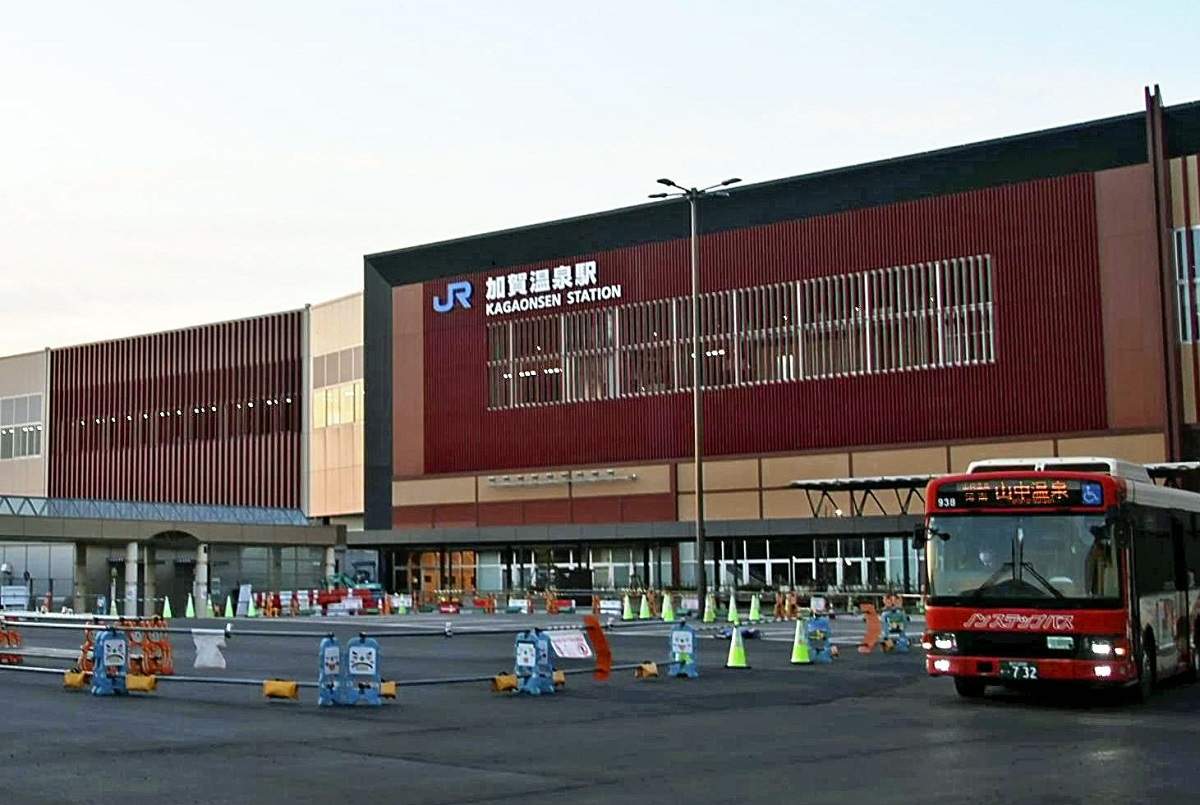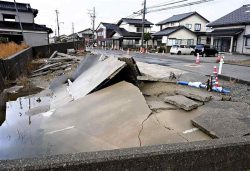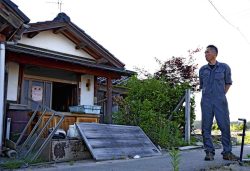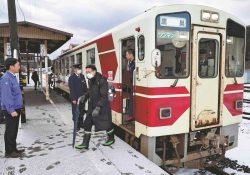Quake-stricken Ishikawa Pref. Looks for Ways to Continue Aiding Disaster Victims While Also Attracting Tourists; Extended Shinkansen Line to Open in March

JR Kagaonsen Station
14:22 JST, February 23, 2024
KANAZAWA — The section between Kanazawa and Tsuruga, Fukui Prefecture, on the Hokuriku Shinkansen bullet train is set to open on March 16. The extension of the line which connects Tokyo and Kanazawa is expected to be a catalyst for tourism in Ishikawa and Fukui prefectures.
But people remain living from many lodging facilities in the prefectures as secondary evacuation sites in the aftermath of the Jan. 1 Noto Peninsula Earthquake, making it a challenge for the region to strike a balance between relief efforts and tourism.
“We would never force you out,” Hisahiko Yoshida, president of resort-hotel Kaga Hyakumangoku in Kaga, Ishikawa Prefecture, told evacuees at a dinner hall on Feb. 11. The hotel has been offering all of its guest rooms to more than 300 evacuees as shelter.
Yoshida also explained plans to renovate the hotel’s employee dormitory and open it to evacuees. “We have a responsibility to help evacuees rebuild their lives to the end,” he said. “But, at the same time, we need to accept tourists. Otherwise, souvenir shops and restaurants will not be able to survive, and the appeal of the entire tourist area will decline.”
Hotels in the prefecture had been preparing for an increase in tourists ahead of the extension of the Shinkansen line. The Development Bank of Japan Inc. estimates the extended services will bring ¥27.9 billion of direct economic benefits to Ishikawa.
However, after the earthquake, everything changed. By the end of January, more than 160,000 reservations were cancelled at six hot spring resorts in the prefecture.
As of Jan. 16, 5,275 people were staying in 245 inns and hotels in and outside of Ishikawa as secondary evacuation sites. Accommodation costs are covered by the central government based on the Disaster Relief Law, but the length of their stay is determined by the prefectural government and the accommodation facilities on a case-by-case basis.
With the opening of the extended Shinkansen line in mind, many facilities plan to allow evacuees to stay until the end of February or March. However, as construction of temporary housing units hold up, it has been difficult to have evacuees move to new accomodations.
Meanwhile, with the JR Kagaonsen station becoming a stop on the new Shinkansen section, reservations and inquiries at inns for March and beyond are increasing in Kaga and other southern parts of the prefecture, where quake damage were relatively small, according to Kaga’s municipal tourism association and others. Travel time between Tokyo to Kagaonsen station will be shortened by 24 minutes to 2 hours and 43 minutes.
The Hotel Arrowle in Kaga also said it has been receiving more reservations. About 140 people from Wajima in the prefecture and other places are currently staying in 60 out of a total of 130 rooms in the hotel.
Hotel president Nagao Ota provided evacuees with card keys which can be used until the end of March, in a hope to offer them rooms as long as needed. The hotel is also considering discounted accommodation packages supporting the Hokuriku region through stimulated tourist demand in order to “respond to the needs of both evacuees and tourists.”
“We want to make the most of the effects of the opening of the extended line to stimulate the prefecture’s economy and support earthquake victims,” Ishikawa Gov. Hiroshi Hase said, calling for tourists to visit the prefecture.
Because staff is limited for promotional events as any Ishikawa prefectural employees are busy addressing disaster related queries, Fukui Gov. Tatsuji Sugimoto told Hase on Feb. 10 his intentions for Fukui to run tourism campaigns for both of the Hokuriku region prefectures.
“It is necessary to create a system where visits to the [Hokuriku] region lead to support of quake-stricken areas,” said Toshiya Hashimoto, a professor of tourism behavior at Rikkyo University and an expert on tourism reconstruction in disaster-stricken areas. “They can sell food and souvenirs from Noto at tourist spots in Kaga, for example. It is also necessary to widely promote such efforts,” he added.
"Society" POPULAR ARTICLE
-

M4.9 Earthquake Hits Tokyo, Neighboring Prefectures
-

M7.5 Earthquake Hits Northern Japan; Tsunami Waves Observed in Hokkaido, Aomori and Iwate Prefectures
-

Tsukiji Market Urges Tourists to Avoid Visiting in Year-End
-

Israeli Tourists Refused Accommodation at Hotel in Japan’s Nagano Pref., Prompting Protest by Israeli Embassy and Probe by Prefecture
-

Beloved Cat Stationmaster Nitama in Wakayama Pref. Passes Away at 15
JN ACCESS RANKING
-

Keidanren Chairman Yoshinobu Tsutsui Visits Kashiwazaki-Kariwa Nuclear Power Plant; Inspects New Emergency Safety System
-

Imports of Rare Earths from China Facing Delays, May Be Caused by Deterioration of Japan-China Relations
-

Japan Exports Rise in October as Slump in U.S. Sales Eases
-

Japan Pulls out of Vietnam Nuclear Project, Complicating Hanoi’s Power Plans
-

Govt Aims to Expand NISA Program Lineup, Abolish Age Restriction






















